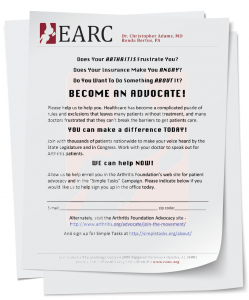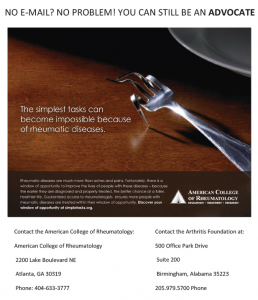Editor’s note: This is the first installment of a two-part series showing how a busy office-based practice can incorporate patient advocacy into its standard workflow. Part 1 outlines the reasons for advocacy and the benefits to both patients and doctors, then gives a quick-start outline to get you started. Part 2 will amplify the concepts explored in Part 1 and offer additional options and ideas to individualize this advocacy to meet your practice’s needs.

Rheumatologists are natural advocates for arthritis patients because we see firsthand the destructiveness of the illnesses we treat.
Image Credit: Volt Collection/SHUTTERSTOCK.COM
The patients in my practice are frustrated; maybe your patients are, too. Have you asked them? Recent healthcare policies have left most patients with higher insurance premiums, larger bills for medicines, higher copays to cover office visits and diagnostic testing, and more treatment obstacles in the form of terse formulary restrictions and prior authorizations for almost everything. Patients often feel powerless to fight the system and advocate for themselves, and many of my patients felt they lacked a mechanism for addressing their concerns.
That’s where we came in.
Rheumatologists Are Natural Advocates
Rheumatologists are advocates for arthritis patients because we see firsthand the medical, psychological and social destructiveness of the illnesses we treat. We support the Arthritis Foundation, we complete disability forms, we submit prior authorization insurance forms, and we speak out in the community to advocate for those we treat. Advocacy is so important to the American College of Rheumatology (ACR) that it is on the banner menu of the ACR website. The ACR’s Simple Tasks Campaign is designed to promote awareness of arthritis-related issues and provide additional advocacy.
We want our patients to be political advocates, writing their insurance companies & their legislators.
Clearly, rheumatologists are at the vanguard of advocacy, but my colleagues express frustration and dismay that we are but a few voices in the din of competing choruses for political attention. Additionally, we are so busy with EMRs, Meaningful Use, Maintenance of Certification and a dozen other administrative obstacles (e.g., filling out those prior authorizations that stand in the way of patient treatment) that there is little time anymore for our advocacy efforts in a busy office practice.
Help Is Out There
In addition to the ACR, many organizations benefit our patients and promote advocacy, including the Arthritis Foundation, the Lupus Foundation of America, the Scleroderma Foundation, the Sjögren’s Syndrome Foundation, the Myositis Foundation and others. There are also general advocacy websites, such as Fail First Hurts, Creaky Joints and the Center for Medicare Advocacy, to name just a few. Despite the presence of these important groups, many patients feel they lack an effective mechanism for expressing their concerns and don’t feel they have a voice in the policy decisions that affect their health.
Lay the Foundation
How can we, as rheumatologists, mobilize the energy of our patients’ frustration and direct it toward changing the policies that work against them? How can we enlist the multitudes of suffering and scared patients to mobilize them into action? The answer is grassroots advocacy directed at patient activism.

(Click for larger image)
Figure 1: Draft Call to Advocacy Letter. Note: Put this on your letterhead, scale it to fit, and edit it as you feel appropriate; this isn’t copyrighted.
The letter was created using professional design resources intended to maximize visual impact, but you should modify to fit your goals and needs. When you do, save it as a PDF to make it more difficult to modify.
Any mechanism for doing this must be simple, direct, easily implemented and unobtrusive to both the patient and the practice. The payoff for the patient may be a feeling that they are no longer pawns sacrificed in the big-stakes chess game of healthcare. The potential payoff for the doctor may be a hundred united voices, not just one, to ask for relief from bureaucratic burdens and respite from obstructionist insurance regulations.
Our efforts were prompted by recent draconian requirements for prior authorization of many medicines by our state’s leading insurance carrier. In a matter of days, we developed and implemented a mechanism for enrolling patients as advocates with the Arthritis Foundation and the Simple Tasks Campaign. In order to have this work well in your practice, lay a foundation by exploring your options and goals, then enrolling your staff in this project. Next, implement some simple steps into your usual office routine. Finally, consolidate your program by making advocacy an integral part of your practice.
Your program requires definition and limits. How much do you want to advocate? We decided to reach out to every patient at every visit, but you might set a more focused goal. The process I describe works for many patients as easily as a few. Do you want to focus on a few specific items, such as political advocacy, or do you want to just encourage patients to participate in foundations? We decided to take an aggressive advocacy route, and selected the Simple Tasks Campaign and Arthritis Foundation Advocates as our initial targets, with plans to broaden our scope to other groups later. We want our patients to be political advocates, writing their insurance companies and their legislators.
Before you get started, you might need to check with any legal advisors to be sure your state or city doesn’t have an obscure rule against your offer to enroll patients in an advocacy program. Our lawyers told us that as long it was voluntary, we were on sound legal footing.
Quick-Start Outline
Having defined your goals, here’s a suggested mechanism for encouraging patient advocacy that I have tested and implemented in my practice:
- Do your homework. Review advocacy sites for arthritis and decide which to use. Start out small, just one or two sites. We selected the Arthritis Foundation and Simple Tasks because of their broad scope and their easy sign-up pages.
- Enlist your staff. Explain the importance of patient advocacy, and how their payoff might be less bureaucratic headaches and hassles for them if we can get patients to help us change the system. Our method doesn’t involve a lot of time or effort. Make your staff advocates, too. Show them the websites for your selected advocacy group and where to sign people up.
- This is one time when it’s OK to copy. Look at advocacy pieces that are already available, and adapt them to your individual practice.
- Feel free to copy our Call to Advocacy draft (Figure 1) and put it on your own letterhead.
- Use a handout similar to the one we designed (Figure 2), called Your Insurance and Our Rheumatology Office. This helps patients understand the impact of their insurance on the care you can give.
- Consider making an alternate handout for patients who lack smartphones or Internet access that has mail addresses and phone numbers of your selected advocacy organizations (more on this in Part 2).
- Incorporate advocacy enrollment into your workflow. This takes just a few steps:
- Upon check-in, give every patient a copy of your advocacy letter and handout (see 3b above, Figure 2).
- When the patient is screened and has vitals done, have the staff verify that the patient has the materials. If not, provide the patient with a copy at this point.
- In the exam room, finish your visit by asking if the patient received the materials, and tell them your staff will be glad to sign them up today, if they desire.
- During checkout and while scheduling a return visit, have the staff ask if they may enroll the patient in your groups right now. It takes less than two minutes for the staff to open websites for the Arthritis Foundation and Simple Tasks to type in an e-mail address and ZIP code.
- If the patient lacks an e-mail address, give them the handout with telephone numbers and mailing addresses (Figure 2).
It’s Easy
It really is that simple. We started doing this one Monday morning after I had spent the weekend brainstorming with some colleagues. You can start this right away in your practice.
In Part 2, I will offer additional tools for advocacy that might make your efforts even more successful. Until then, I encourage you to get started and begin recruiting your army of patient advocates.
Christopher D. Adams is chief of rheumatology for the East Alabama Rheumatology Center in Auburn/Opelika. His experience includes military medical practice, health delivery logistics and planning for the military, clinical faculty at several medical schools, conducting clinical research and serving as a liaison for dialogues between the Alabama Society for the Rheumatic Diseases and managed care, as well as government entities.
Note: The opinions expressed are the author’s and don’t necessarily reflect the official views of the ACR.

